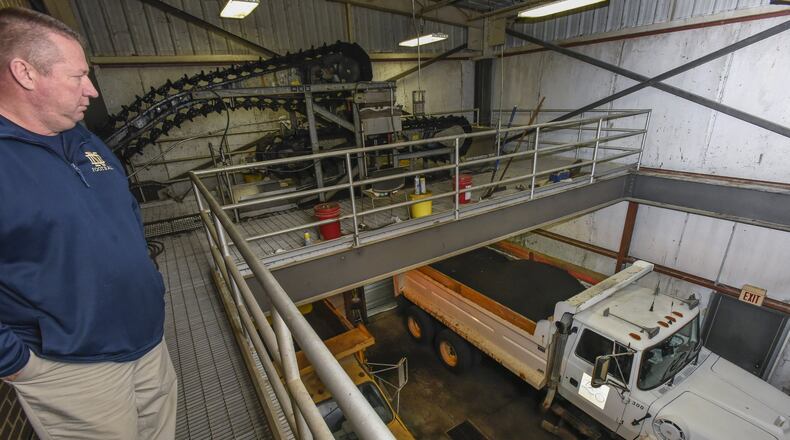Bob Leventry, director of the county’s Water & Sewer Department, said the four governments, which together produce about 40,000 wet tons of bio-solids, could save costs of disposing some of that material in landfills like the one Rumpke operates in Hamilton County’s Colerain Twp.
The materials would be placed in an “anaerobic digester,” and processed in the absence of oxygen, to produce methane, which can be scrubbed and used to heat homes; or could be run through a generator to create electricity.
“We see the possibilities of converting a bio-solids waste product into renewable energy,” Leventry said.
Currently, Butler County transports its wastes to an energy-recovery facility that uses similar processes and is operated by Renergy Inc., near Fairborn.
Middletown’s sewage plant produces about 15,000 dry tons of processed bio-solids per year. Those are applied to farm land as a fertilizer and soil conditioner.
When the wastes are shipped to a landfill, the local governments must pay a disposal fee. When the wastes are applied on farmers’ fields, some of the farmers accept it at no cost, but it still must be trucked to them, Leventry said.
Fairfield now contracts with Baltimore-based Synagro, which applies its solids to fields. Fairfield already has anaerobic digesters that process the sludge, break it down, reduce odors and pathogens before Synagro applies it to farm fields.
“The farmers really like it, it’s free fertilizer, basically, for their farmlands,” said Fairfield Public Utilities Director Adam Sackenheim. Currently, Fairfield spends about $70,000 on bio-solids disposal, far less than it would cost to use landfills. Fairfield also recovers some methane from its processes, which it uses for city operations.
“I feel like the city is probably in a good place for the next five years, maybe the next 10 years, when it comes to what we’re doing with bio-solids,” Sackenheim said. “But of course, that’s all dependent on regulations not changing.”
If regulations tighten, “It would be good to have other options potentially available, or to have at least been evaluated,” Sackenheim said.
“We’ve got a whole lot of waste material in this one area,” Sackenheim said. “We’re all handling it a little differently, and independently, right now. If we handled it through one facility, or one process, what could we do with it? Could we do something better? Could we generate electricity? Generate a better final product?”
Hamilton also works with Synagro, but there are times of the year, especially during the winter, when its wastes go to to Rumpke’s landfill, said city Director of Underground Utilities Dwight Culbertson.
“We’re going to see more and more of this, as we start to really think about issues of sustainability, and energy, and just being able to use our resources more prudently,” Culbertson said, noting such facilities can shrink local governments’ carbon footprints.
Culbertson noted the methane from the process would have to be cleaned, but then could be compressed and used in vehicle-filling stations, like at one in Columbus. It also can be used in electricity-generating facilities.
“A lot of things are going on in the state, a lot of new initiatives are being considered, and some are well under way,” Culbertson said.
“What we’re applying for is a grant to do a study — to see if it’s feasible to do a regional bio-solids processing and energy-use facility,” Leventry said. Applications for the grant are due in early 2017.
There are many questions that the study will answer. Among them:
- What would the facility's economics be?
- How much material could be handled?
- How big should it be, and how much would it cost to build?
- How much electricity can be created that could be sold to the grid?
- How many renewable energy credits could the facility earn?
It’s unlikely the facility would be a money-maker, Culbertson suspects. Instead, he believes its biggest value to the local governments would be “just offsetting the costs of operating” treatment plants.
Equally promising is the ability for such a facility to accept high-carbon wastes from industries and food-producers, rather than being sent to landfills: “This could be something that they could bring their waste to, also,” Culbertson said. “And when it comes to producing methane gas, the more complex carbon wastes, they’re also beneficial in producing the methane.”
Aside from creating a larger economy of scale, the regional approach may have another benefit: “We think our application for these grant funds will score better because … you earn extra rating points by approaching it as a regional project,” Leventry said.
About the Author
